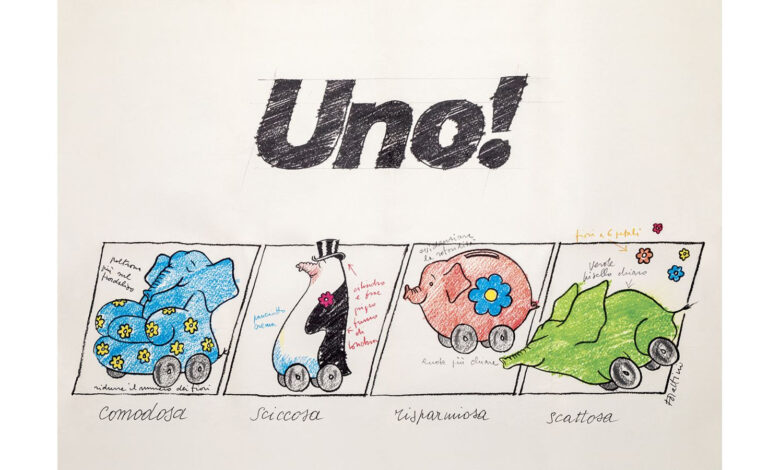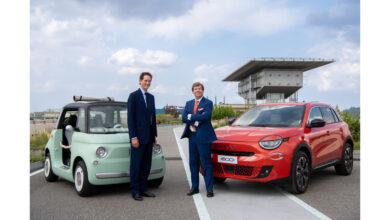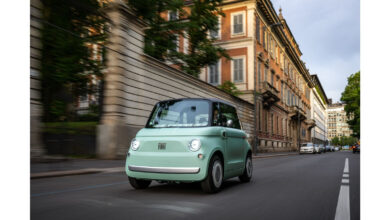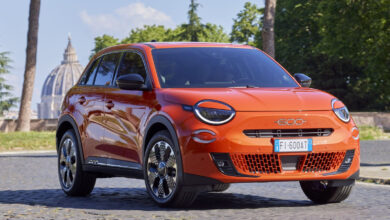The Fiat Uno: Forattini’s “rivoluzionosa” ad campaign 40 years on
The cartoonist’s ad campaign interpreted the world of the automobile through the world of the imagination. The penguin, piggy bank, and two elephants ironically and playfully represented the peculiarities of the new Fiat Uno, the most modern city car at the time. He invented neologisms in Italian like “sciccosa" (swanky), "comodosa" (comfy and cozy), "scattosa" (snappy) and "risparmiosa" (money-saving). The musical postcard “The voice of the Uno!” invited the public to visit dealerships and check out the car. Pencil drawings were used as an effective instrument for conveying the vehicle’s complex technologies. The Uno is a legendary model which has stood the test of time. At this link there is a special video with stock images and words from Roberto Giolito, the Head of Stellantis Heritage (Alfa Romeo, Fiat, Lancia, Abarth), and Maurizio Torchio, the Head of Centro Storico Fiat.

Ever since its launch in 1983 it was clear that the Fiat Uno would break the mold for city cars and alter FIAT history. This was made further evident by the enormous investment for its creation (more than a trillion lire) and the choice to introduce it at Cape Canaveral, Florida, the launch and landing site of United States’ space program’s most advanced spacecraft: the Shuttle.
Such a bold juxtaposition was well-suited to the Fiat Uno, the most innovative car in its segment (“Car of The Year” in 1984). It was also the first vehicle to “speak” through an ad campaign which used irony, lightheartedness, and extremely modern language. The latter aspect of the Fiat Uno is the focus of the special video created by Stellantis Heritage which includes stock images and words from Roberto Giolito, Stellantis Heritage (Alfa Romeo, Fiat, Lancia, Abarth), and Maurizio Torchio, the Head of Centro Storico Fiat.
The clip can be seen at this link.
To introduce the public to this technological gem, Fiat went for an unusual ad campaign made by one of the most famous cartoonists of the time: Giorgio Forattini. These were the years of Bonelli comics, Japanese cartoons, and Italian episodes of the series “Wacky Races”. Illustration was becoming more and more popular among young people and pencil drawings were becoming a form of scathing satire which gave way to deeper reflections thanks to their intuitive nature.
“The campaign created by Forattini was sensational and revolutionary as it interpreted the world of the automobile through the world of the imagination,” stated Roberto Giolito. “In fact, in response to traditional questions from the public like ‘How does it work?’, ‘What does it look like?’, and ‘How does it drive?’, the famous cartoonist responded with cute characters which took the car’s place: elephants, a penguin, and a piggy bank. Back then it was fashionable to give cars names of animal inspiration. For example, the Fiat 500 A was known as the “Topolino” (Mickey Mouse). Instead, Forattini invented his own characters which stunned the world by expanding the campaign’s audience to both children and those who enjoy high-quality satire.”
A “rivoluzionosa” communications campaign
Forattini’s caricatures immediately became famous along with the neologisms the cartoonist created specifically for the campaign: “sciccosa” (swanky), “comodosa” (comfy and cozy), “scattosa” (snappy) and “risparmiosa” (money-saving). These new adjectives ironically and playfully described the peculiarities of the new Fiat Uno and were so catchy that they became part of common speech. After all, advertising has always created neologisms which catch on thanks to their ability to indelibly link images and words. Maurizio Torchio recalls that “the use of words which ended with “osa” immediately caught on. Just think about the famous “pertinosa” which was linked to Forattini’s caricature of Sandro Pertini, Italy’s President at the time. That word essentially became of way speaking, thinking, and was surely a product of a lightness and subtle irony which fit in well during the Eighties.”
Each neologism corresponded to one of the car’s peculiarities and benefits for the customer
The “scattoso” elephant highlighted the snappy Fiat Uno engines, which were available in three different displacements and two powers, including the smallest aspirated diesel one on the market. But the model’s true “heart” would change its, and the entire Italian brand’s, history two years later: the FIRE 1.0 engine, debuting on the Fiat Uno. What can be said about Forattini’s second elephant? Its flower-covered, sofa-shape still brings about feelings of joy and tenderness. Beyond the comfy and cozy adjectives used to describe it lies the vehicle’s front and rear roominess. It even looked like a predecessor to the minivan which was made for taking on long trips with ease. The third character is an elegant penguin which was linked with the “sciccosa” (swanky) neologism highlighting the vehicle’s elevated construction quality and distinctive design by Giugiaro. Lastly, the piggy bank focused on the model’s “risparmiosa” (money-saving) aspect in terms of fuel economy and operating costs.
“Ciao! I am the new FIAT Uno!“, the original greeting recorded on vinyl
Forattini’s ad campaign worked so well that it moved beyond the confines of print media and made its way into everyday life. However, concealed behind that light and ironic ad, there was the pride of an industrial group which was rich in technologies and state-of-the-art production processes. This can be seen well in the “The Uno is a FIAT” tagline with FIAT’s famous four vrooms—signatures of a clear and strong institutional image. Forattini’s drawings were not the only ones to accompany the new vehicle. How can one forget the famous “splendida italiana” tagline or the funny TV spots with the nun who didn’t know how to drive or the young couple under a waterfall with the Uno nearby? The latter immediately recalled films set in exotic locations like The Blue Lagoon (1980) and Paradise (1982) which young people were crazy about at the time.
There was also the original promotional postcard entitled “The voice of the Uno”, which invited the public to head to dealerships to check out the car. All one had to do was open the envelope, fold the upper part where there was a steel stylus, insert a finger in the vinyl hole and rotate it at a speed of 45 rpm. As if by magic, especially for the little ones, a female voice could be heard saying, “Ciao, I am the new FIAT Uno”. The brand had done it once again.
Pencil drawings as an effective and contemporary tool for conveying a product
The Forattini campaign left behind a simple yet profound way of storytelling, i.e., advertising that engages the public through emotions and memories and creates an immediate hook. Even though current ad campaigns no longer use illustrators or cartoonists, pencil drawings are an extremely effective tool for extrapolating a product’s essential qualities, even those which are more complex and technological. Roberto Giolito ends by saying that “much of the vehicle information today gets seen on the screens onboard, which are in turn connected to displays on our phones. We are completely surrounded by visual and acoustic messages. With this in mind, a pencil can explore things one can’t see or touch, sketch out their benefits and advantages, and then communicate them to the public in an intuitive way.”
A legendary model which has stood the test of time
Produced from 1983 to 1995, the Fiat Uno achieved remarkable success in Italy and abroad, as demonstrated by the 9 million models sold and the countless versions which followed throughout the years. Its rich history began in 1983 when it made its world premiere in the USA in an exemplary moment in advertising history. Forty years have passed since the birth of this archetype which changed the way we experience, communicate, and produce cars. And a Selecta version of the Uno, equipped with a continuously-variable automatic transmission, is on display in the Archistars area of the Heritage Hub in Turin with other models which revolutionized the architecture of automobiles while respecting the tenets of productivity and functionality. The Fiat Uno was without a doubt an authentic world-car not only in terms of sales but also with respect to the places in which it was made. At times it changed its name, as in Brazil where it was called the Mille, but it went practically untouched from a formal point of view, which proves that this successful project was able to stand the test of time.





